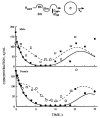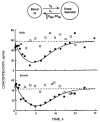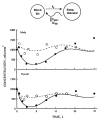Gender-based effects on methylprednisolone pharmacokinetics and pharmacodynamics
- PMID: 8222483
- PMCID: PMC4207261
- DOI: 10.1038/clpt.1993.167
Gender-based effects on methylprednisolone pharmacokinetics and pharmacodynamics
Abstract
The pharmacokinetics and selected pharmacodynamic responses to methylprednisolone were investigated in six men and six premenopausal women after a dose of 0.6 mg/kg ideal body weight. Women (luteal phase) exhibited a greater methylprednisolone clearance (0.45 versus 0.29 L/hr/kg) and shorter elimination half-life (1.7 versus 2.6 hours) than men. The volume of distribution of methylprednisolone was similar when normalized for ideal body weight. Pharmacodynamic models were used to examine the methylprednisolone suppressive effects on cortisol secretion and basophil and helper T lymphocyte trafficking. A significantly smaller 50% inhibitory concentration (IC50) value (0.1 versus 1.7 ng/ml) was seen in the women for suppression of cortisol secretion, indicating increased sensitivity. However, the area under the concentration-time curve of effect was similar for both groups. The IC50 values for effects of methylprednisolone on basophil trafficking related to estradiol concentrations in a log-linear fashion in women, with increased sensitivity found at higher estradiol concentrations. Men displayed a greater 24-hour net suppression in blood basophil numbers, but no difference was observed in net cortisol and helper T lymphocyte suppression between the sexes. These findings suggest that methylprednisolone dosages should be based on ideal body weight. Although women are more sensitive to methylprednisolone as measured by cortisol suppression, they eliminate the drug more quickly, generally producing a similar net response.
Figures





References
-
- Wilson K. Sex-related differences in drug disposition in man. Clin Pharmacokinet. 1984;9:189–202. - PubMed
-
- Cotton P. Is there still too much extrapolation from data on middle-aged white men? JAMA. 1990;263:1049–51. 1055. - PubMed
-
- Council on Ethical and Judicial Affairs, American Medical Association. Gender disparities in clinical decision making. JAMA. 1991;226:559–62. - PubMed
-
- Levey BA. Bridging the gender gap in research. Clin Pharmacol Ther. 1991;50:641–6. - PubMed
-
- Greenblatt DJ, Allen MD, Harmatz JS, Shader RI. Diazepam disposition determinants. Clin Pharmacol Ther. 1980;27:301–12. - PubMed
Publication types
MeSH terms
Substances
Grants and funding
LinkOut - more resources
Full Text Sources

